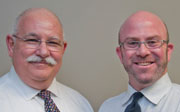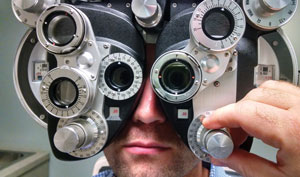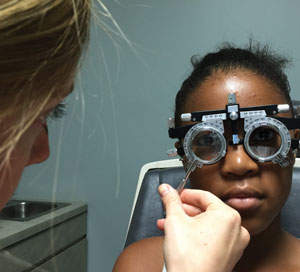 |
Occasionally, patient refraction takes longer than it should. Patients may struggle when the differences in refractions just aren’t enough to trigger a significant response, in other words, they can’t decide “which is better, one or two.” On top of that, many patients are convinced they will receive the wrong prescription if they answer even one question incorrectly. It is in these cases that the use of “just-noticeable differences” (JND), or the minimal amount of change needed to produce an effect, can be hugely beneficial.
Jackson Cross Cylinder
Imagine, for example, you have identified a cylinder of 0.75 x 90 in one eye using either your retinoscope or autorefractor. First, consider your tools. Typically, the cylinder finding is refined using the Jackson Cross Cylinder (JCC). A JCC is any lens power that is a spherical equivalent plano-powered lens. Examples include +0.25 sphere with -0.50 cylinder or +0.50 sphere power with -1.00 cylinder power, otherwise specified as ±0.25 or ±0.50.
 | |
| A patient uses a phoropter during an routine examination. | |
 | |
| A Southern College of Optometry intern performing cylinder testing using a handheld Jackson Cross Cylinder of +/- 0.50. |
When equipping an exam lane with a new phoropter, specify the power of the JCC that is built in for the cylinder testing. Some believe the use of the ±0.25 JCC will lead to a more refined prescription, but we’ve found using a JCC with a greater power, such as ±0.50 or even ±0.75 for some low vision or macular degeneration patients, helps us progress through the refraction process quicker and more reliably.
The Questions Five
We put this theory to the test to see if a cylinder would reveal itself in a minimum of five questions with the JCC.
First, we tested the axis at either 75° or 105°, and increased the power of the cylinder by -0.25 to -1.00 to boost the patient’s sensitivity. Now, the steps that will lead you to the goal: if we present the patient with two choices, assuming we have performed retinoscopy well, they will generally pick the axis towards our scope.
We then shifted 15° on either side of 90° and repeated the probe again, expecting an indication that directs up back towards 90°. Only two questions in and we had already finished checking the axis. Note: with higher power cylinders, we move the axis less than 15°.
The next step is moving the cylinder back to 90° and rotating the JCC for power testing. Remember, we increased the power by -0.25. At this point, we asked the patient if she wanted more power, or if the original amount sufficed. Again, if our retinoscopy skills are up to snuff, the patient will indicate they want less power. So, we removed -0.50 of cylinder power and returned to a point of less power than what we scoped.
Next, we asked if she wanted less cylinder power or the amount found via retinoscopy. Generally, the patient will answer more.
Finally, we reached question five. By this time, we expected our patient to first choose between two presentations that look fairly similar. Since we tested both greater and lesser power, we sought to determine if she wanted this power, or if it looks too similar to the lower power. Our bias is always towards the lower power; however, if the patient hesitates, generally it indicates a desire for less power, and we should assume the refraction will include a cylindrical component of -0.50 x 90.
In future articles, we will demonstrate how increasing JNDs applies to other aspects of the refraction technique. We hope, however, that by going through this thought experiment and trying it with a few patients, that you find yourself asking fewer questions and, ultimately, having shorter appointments. Let us know!| A Pearl to Remember Sometimes, the most efficient method may appear to be slower than one expects it to be. Here is one such case: At the end of their second year at Southern College of Optometry, as part of the approval process before seeing real patients, students are put through timed checkouts. They get used to asking, “Which is better, one or two?” and flipping the JCCs so quickly one might wonder what the mock patients can actually see, let alone report. Many of us have found patients ask to see the choices over and over again. Well, here is a place we can all benefit from “training” the patient and not letting them usurp the refraction process. If my patient asks to see the choices again, I may decide to pull away the phoropter and say something like: “The system we use will hone in on what is best for you. You needn’t worry at all about making a mistake. What I’m after is your impression about which one of the presentations you like better. I’ll slow down and give you plenty of time to look at each, but I want your first impression.” I found that this works well in helping free the patient from worry. Our students find slowing down difficult, but eventually they all get it. Pausing for about two seconds on each presentation does the trick. |

